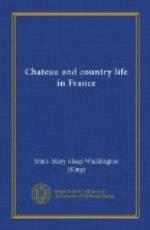The pack of hounds, white with brown spots, big, powerful
animals, gave the valets de chiens plenty to do.
Apparently they knew all their names, as we heard frequent
admonitions to Comtesse, Diane (a very favourite name
for hunting dogs in France), La Grise,
etc.,
to keep quiet, and not make little excursions into
the woods. As the words were usually accompanied
by a cut of the whip, the dogs understood quite well,
and remained a compact mass on the side of the road.
There was the usual following of boys, tramps, and
stray bucherons (woodmen), and when the day was fine,
and the meet not too far, a few people would come
from the neighbouring villages, or one or two carriages
from the livery stables of Villers-Cotterets, filled
with strangers who had been attracted by the show and
the prospect of spending an afternoon in the forest.
A favourite meet was at the pretty little village
of Ivors, standing just on the edge of the forest
not far from us. It consisted of one long street,
a church, and a chateau at one end. The chateau
had been a fine one, but was fast going to ruin, uninhabited,
paint and plaster falling off, roof and walls remaining,
and showing splendid proportions, but had an air of
decay and neglect that was sad to see in such a fine
place. The owner never lived there; had several
other places. An agent came down occasionally,
and looked after the farm and woods. There was
a fine double court-yard and enormous “communs,”
a large field only separating the kitchen garden from
the forest. A high wall in fairly good condition
surrounded the garden and small park. On a hunting
morning the little place quite waked up, and it was
pretty to see the dogs and horses grouped under the
walls of the old chateau, and the hunting men in their
bright coats moving about among the peasants and carters
in their dark-blue smocks.
The start was very pretty—one rode straight
into the forest, the riders spreading in all directions.
The field was never very large—about thirty—I
the only lady. The cor de chasse was a delightful
novelty to me, and I soon learned all the calls—the
debouche, the vue and the hallali, when the poor beast
is at the last gasp. The first time I saw the
stag taken I was quite miserable. We had had
a splendid gallop. I was piloted by one of the
old stagers, who knew every inch of the forest, and
who promised I should be in at the death, if I would
follow him, “mais il faut me suivre partout,
avez-vous peur?” As he was very stout, and not
particularly well mounted, and I had a capital English
mare, I was quite sure I could pass wherever he could.
He took me through all sorts of queer little paths,
the branches sometimes so low that it didn’t
seem possible to get through, but we managed it.
Sometimes we lost sight of the hunt entirely, but
he always guided himself by the sound of the horns,
which one hears at a great distance. Once a stag
bounded across the road just in front of us, making
our horses shy violently, but he said that was not




